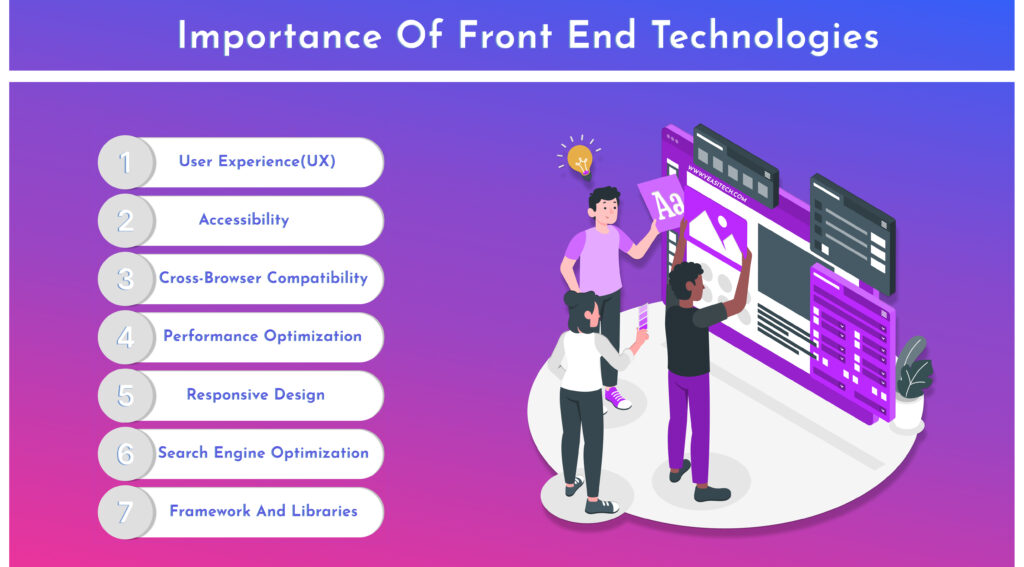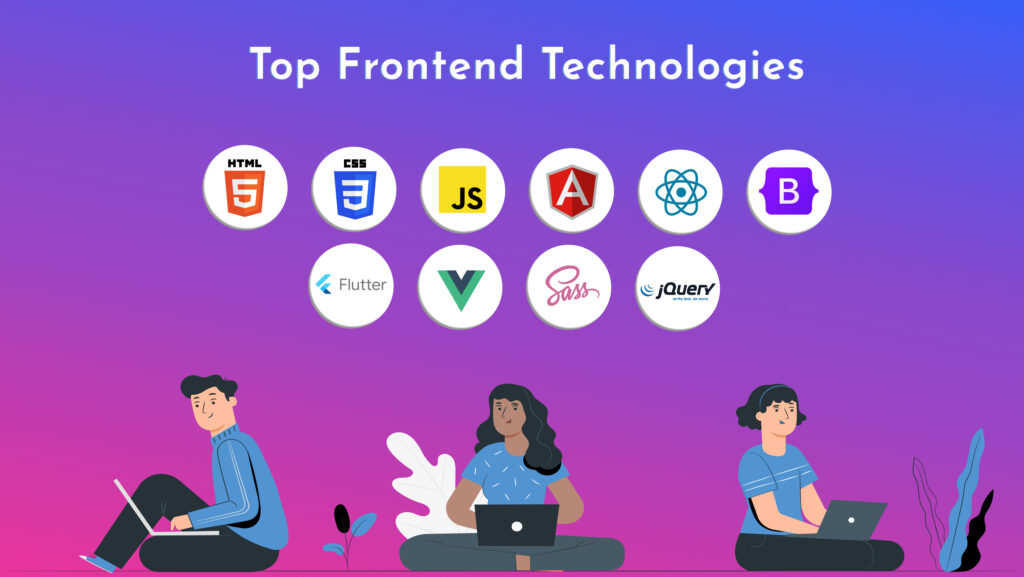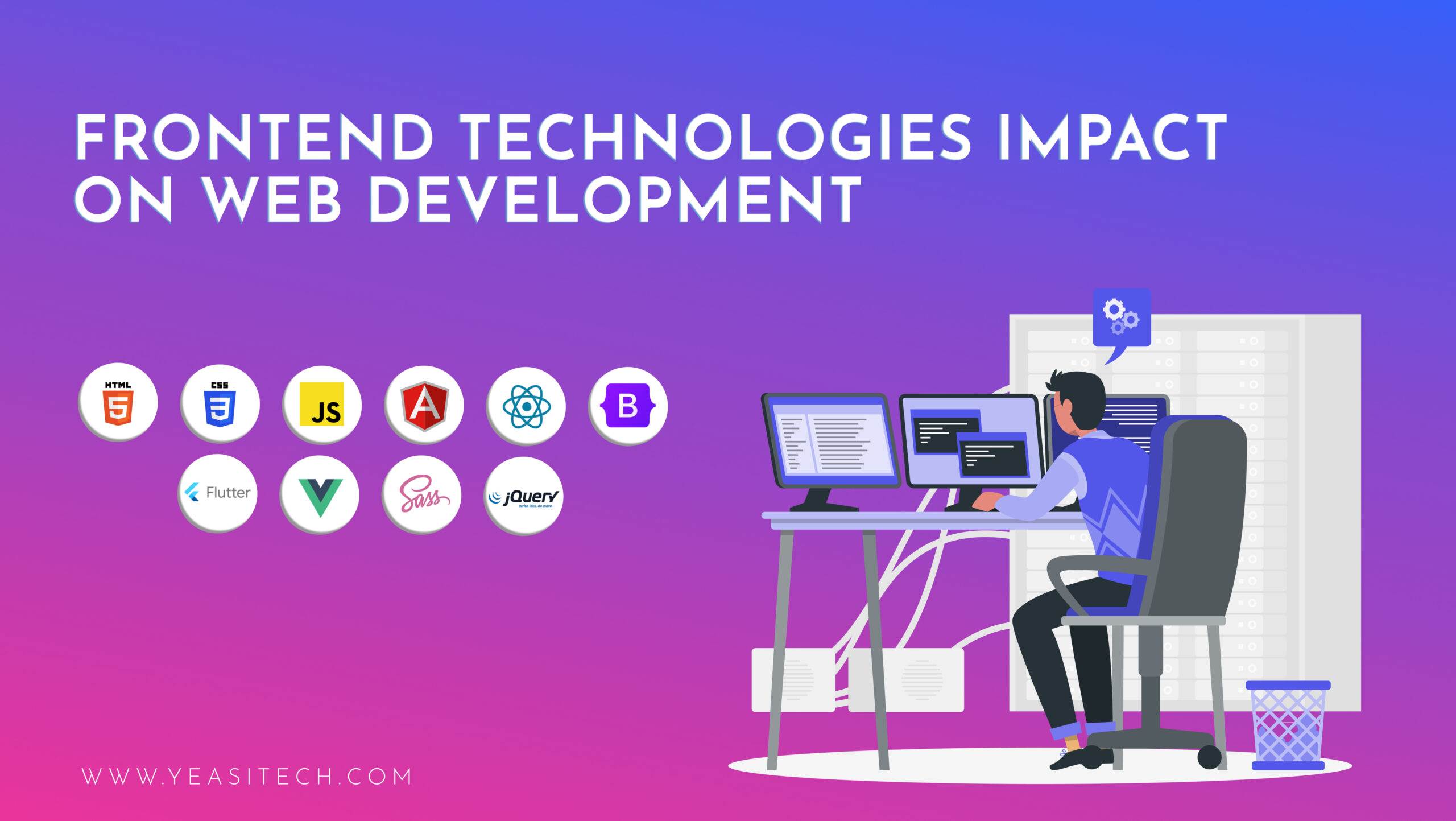Web development featuring a focus on user interfaces is known as front-end development. A graphical user interface is generated by transforming the backend code. The term frontend technologies describes the tools, frameworks, and technologies used in the development of a website’s user interface (UI) and user experience (UX). The area of a website’s application where users directly interact is called the frontend. Button, form, menu, and content display are just a few examples of what consumers can view, touch, and interact with on their screens. Let’s explore front-end innovation in this article.
Table of Contents
What is front-end development?
Website development can be divided into two categories: front-end and back-end. The menus, images, and other features that are displayed on the screen are known as the front-end system design. The visual appearance of the website is mostly the responsibility of front-end developers. The visual appearance of the website is mainly the responsibility of front-end developers.
The Top Reasons Why Frontend Technologies Is Important

A number of benefits that frontend development provides improve the general performance and success of web apps. The following are some main benefits of top-frontend technology
1. User Experience: The primary objective of frontend developers is to create an interface that is both visually appealing and simple to use. Front-end developers are in charge of designing the user interface (UI) and making sure that the user has a satisfying experience (UX). Their main concern lies in developing and implementing simple and user-friendly interfaces that attract and excite users.
2. Responsive Design: The growing use of mobile devices has made responsive design essential. Websites can adjust to various screen sizes and resolutions by using responsive techniques, which are implemented by front-end developers. This guarantees the website seems great and functions properly across desktop, laptop, tablet, and smartphone platforms.
3. Visual Design: To make visual designs come to life, front-end experts collaborate closely with web designers. They use HTML, CSS, and JavaScript to convert design prototypes into working websites. Their knowledge of the rules of design and attention to detail goes a long way toward making visually appealing websites.
4. Accessibility: The development of online apps that are accessible to users with problems is a top priority for front-end developers. The most important objective of front-end developers is to build websites that are usable by everyone, including those with disabilities. They include features like keyboard navigation, alternative text for images, and proper heading layout while following web accessibility demands.
5. Performance Optimization: Website performance is made better by front-end developers through the use of caching strategies, lowering file sizes, and limiting HTTP requests. With faster-loading webpages, users will have a better experience, and search engine rankings will improve.
6. Cross-Browser Compatibility: Front-end developers make sure that applications and websites function properly in a variety of web browsers. Front-end experts make sure that websites run uniformly in different web browsers, including Edge, Chrome, Firefox, and Safari. All users benefit from a smooth experience and a larger audience reach as a result.
7. Enhance your SEO: As modern search engines’ algorithms are always evolving, make sure your web application is optimized to create a reliable supply of new clients. You simply cannot pass up the opportunity to increase traffic by adhering to SEO principles and putting best practices into effect.
2024’s Top 10 Frontend Technologies

The front-end system designs listed below are often used in web development:
1. HTML5 Boilerplate
One of the best front-end templates available is HTML5 Boilerplate, which helps in the development of accurate, quick, and flexible websites and web apps with pre-built features. The framework is a set of resources for creating websites that run across different browsers, including HTML5. Key features of the HTML5 boilerplate are as follows:
- HTML5 boilerplate promotes the use of multimedia queries that are customized to the content of each page.
- All the necessary components are included in the HTML5 boilerplate, along with supplementary documentation.
- Using Initialize, you can use it to create templates based on Boilerplate and select the elements you want to keep and discard the ones you don’t.
2.React.Js
React.js is a fast-growing open-source JavaScript library that is frequently used in the development of websites and web-based applications. Let us provide you with a few of the most important benefits of React.js in web app development best practices:
- According to components that can be reused and the ability to merge HTML with JavaScript, which greatly simplifies the development process, React.js development is fast and inexpensive.
- SEO-friendly and highly performant websites are driven by React.
- Excellent UI and UX are delivered with React development.
- Code stability is guaranteed via React.
- Learning in the library is simpler than in other places.
3.Angular.js
An open-source web framework and flexible front-end development tool built using JavaScript is called Angular.js. Its main objective is to make app development and testing simple and easy. Furthermore, it offers model-view-controller (MVC) and model-view-view-model (MVVM) architectures on the user side. The website is highly dynamic and responsive because of the basic HTML and DOM techniques. The best features of Angular.js are testing features, directives, multiple templates, two-way data binding, and dependency injections. Key features of Angular.js are as follows:
- For simpler application development, testing, and understanding, Angular comes with integrated injection functionality.
- Without writing separate programs, data binding is possible with Angular. Connecting data from the HTML control to application data only requires a few snippets.
- Angular comes with a number of built-in services, such as HTTP, which are singleton objects that need only be created once within an application’s framework.
4.Vue.js
Because of its simple nature and adaptability, Vue.js is lightweight and versatile. Developers can use this progressive JavaScript framework gradually because it’s simple to build into already-existing projects. Reactive and dynamic user interfaces are a specialty of Vue.js, which makes it a great option for both small and large-scale projects. Vue.js excels at creating reactive and dynamic user interfaces, which makes it a fantastic choice for projects of all sizes.
5. Bootstrap
An open-source, cost-free CSS framework is called Bootstrap. Its objective is to produce front-end web development that is simple, mobile-first, and responsive. It offers design templates for a variety of interface aspects, including buttons, forms, typography, and navigation.
It is an effective front-end development solution for mobile apps and websites that promotes greater responsiveness. One of its primary features is that it makes the process of creating educational websites simpler. One of the main components of the Bootstrap framework is the jQuery plugins. The key features of bootstrapping are as follows:
- The Bootstrap framework has a number of components that may be quickly incorporated into your website, including progress bars, drop-down menus, thumbnails, and navigation bars.
- Bootstrap offers responsive utility classes that enable targeted content to show or disappear exclusively on specific devices, which is useful for SaaS development.
- Though its 12-column responsive grids, layouts, and components are responsive, Bootstrap is fully adjustable.
- Responsive utility classes, which may make specified content show or hide only on specific devices, are included in Bootstrap for efficient SaaS development.
6.jQuery
The JavaScript library jQuery, which is licensed under the MIT license, was developed to make HTML DOM tree navigation and manipulation easier. Also, it can be used for CSS animation, Ajax, and event management. Among front-end web developers, jQuery is one of the most widely used tools, selected by 48.7% of developers. Its library is used three to four times as frequently as any other product of a similar nature on the market because of its fantastic animations, simple navigation, and abstractions for low-level interactions.
jQuery is beginner-friendly because of its readability, reusable, minimal, and easy coding with API documentation, cross-browser compatibility, and subtle design.
7. Flutter
One of the front-end frameworks with the fastest growth rates for creating functional and adaptable websites is called Flutter. Google created the cross-platform, open-source Flutter user interface framework. It helps create native-like, adaptable programs with a single codebase. Developers can use the Dart programming language to quickly construct cross-platform apps with Flutter. The key features of Flutter are as follows:
- The technology provides widgets for creating unique, customized designs. Cupertino and Material Design widgets are the two sets of widgets.
- The Flutter framework gives you complete control over the codebase of your app, including developer tools, automated testing, and all you need to create beautiful apps.
- Writing code only once and then maintaining and delivering it to numerous platforms and devices is made possible by Flutter’s multiplatform ability.
8. NPM
A cross-platform run-time environment for the JavaScript programming language is called NPM. Using a command-line client, it establishes a connection with the remote registry and manages locally installed and configured JavaScript tools as well as those that are globally used. Finding, setting up, creating, and releasing node applications are its main purposes. Working with both server-side and client-side apps, it is a full-stack development tool. NPM offers event-driven APIs that enable non-blocking executions and run on a single-threaded, event-based loop. It is autonomous. It is a scalable, user-friendly front-end programming platform that facilitates the growth of huge, vibrant, and productive communities.
9. Sass
Sass, or Systematically Awesome Stylesheets, is used to provide additional style and clarity to fundamental CSS languages. This pre-processor is used with variables, mixins, inline imports, nested syntax, and rules. Additionally, it supports quick, compact, and well-structured stylesheets. The superset of CSS is written in Ruby and is based on the JavaScript programming language. Less CSS and fewer codes are permitted in programming structures. This strong, constant, safe, and dependable Sass framework is preferred by developers. Additional options for nesting include math operations and color manipulation. The entire output produced by Sass is well-formatted and customizable.
10. Google Fonts
Google’s web font service is an interactive web directory with a font library, as well as APIs for fonts used by CSS and Android, that is available as a free and open-source utility for developing Android front-end applications. It produces interesting, entertaining, and interactive websites that are reliable and have high performance. It offers a large selection of strong categories with free and open-source typefaces, fonts, and icons. Google typefaces are used by about 60778 businesses, including YouTube, in their tech stack.
Tips for Selecting the Best Web Front-End Technologies
Selecting an appropriate front-end technology is important when outsourcing application development. But before doing so, the following aspects must be taken into consideration:
- Whether the specific technology satisfies the requirements of your project
- How many dashboard-style dynamic value items are there?
- The total number of teams designated for the project.
- Whether the layout consists of several pages with related elements.
- Does the project require SSG or SSR?
- Scalability
- The developers’ expertise with particular technology
- How popular the tool or framework is and, consequently, the size of the audience is.
Which tool is ideal for developing front-end applications?
It is impossible to name one tool as the best. Each developer has a preferred method. Yet, the most often used frameworks are jQuery, React.js, and Angular.js, which are favored by 48.7%, 31.3%, and 30.7% of those surveyed, respectively.
Do front-end developers have a future?
Yes, front-end developers are becoming more and more in demand due to the increased need for social media networking, internet marketing, and digital transformation.
What is the difference between frontend and backend technologies?
Front-end technologies are used by developers to construct a website’s visual components, which users can view and interact with. However, back-end technologies are employed in the development of a website’s or application’s server-side elements, which maintain data, do calculations, and authenticate users.
